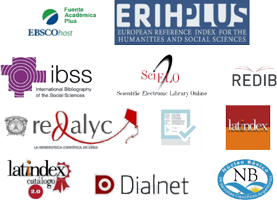What Factors Influence the Building of Smart Cities? A Multilevel Model with Data at Urban and National Levels
Keywords:
smart cities, ICTs, multilevel regression modelsAbstract
In recent years, importance has been placed on the concept of “smart cities”. Two visions can be identified: one that centers on the role of Information and Communication Technologies (ICTs), and one that amplifies the ideas linked to sustainable economic growth, quality of life, participative governance and reduction of emissions. This paper compares these visions to analyze the factors that affect the building of smart cities. On the basis of a sample of 181 cities in 81 countries, a multilevel regression model is estimated, with data at urban and national levels. The results obtained show that the model aligns better to the first vision: the financial and educational levels, the location within Latin America and the fact that they are cities in countries that are developed in terms of ICTs are factors that positively affect the cities' smartness. On the other hand, the second model shows that the lower the urban unemployment rate is, the higher the cities’ smartness.Downloads
References
ALBINO, V., UMBERTO, B. y DANGELICO, R. M. (2015): “Smart cities: definitions, dimensions, and performance”, Journal of Urban Technology, vol. 22, n° 1, pp. 3–21.
ANTHOPOULOS, L. y FITSILIS, P. (2010): “From Digital to Ubiquitous Cities: Defining a Common Architecture for Urban Development”, Proceedings of the 6th International Conference on Intelligent Environments IE10, Malasia, IEEE, pp. 301-306.
BELISSENT, J. y GIRON, F. (2013): Service Providers Accelerate Smart City Projects, Forrester Research Report, Cambridge, Forrester Publication.
CARAGLIU, A., DEL BO, C. y NIJKAMP, P. (2009): Smart Cities in Europe, 3rd Central European Conference in Regional Science, Košice, 7-9 de octubre.
CLAYTON, J. y MACDINALD, S. J. (2013): “The limits of technology”, Information, Communication & Technology, vol. 16, n° 6, pp. 945-966.
DEBNATH, A. K., CHIN, H., HAQUE, M. y YUEN, B. (2014): “A methodological framework for benchmarking smart transport cities”, Cities, vol. 37, pp. 47-56.
DE LA CRUZ, F. (2008): “Modelos Multinivel”, Revista Peruana de Epidemiologia, vol. 12, n° 3, pp. 1-8.
DIEZ ROUX, A. (2002): “A glossary for multilevel analysis”, Journal of Epidemiology and Community Health, n° 56, pp. 588-594.
FLORIDA, R. y MELLANDER, C. (2012): “The Rise of Skills: Human Capital, the Creative Class and Regional Development”, CESIS Electronic Working Paper Series, n° 266.
GIBSON, D. V., KOZMETSKY, G. y SMILOR, R. W. (1992): The technopolis phenomenon: Smart cities, fast systems, global networks, Lanham, Rowman & Littlefield Publishers.
GIFFFINGER, R., HAINDLMAIER, G. y KRAMAR, H. (2010): “The role of rankings in growing city competition”, Urban research & practice, vol 3, n°3, pp. 299-312.
GLAESER, E. L. y SAIZ, A. (2004): “The Rise of the Skilled City,” Brookings-Wharton Papers on Urban Affairs, pp. 47–94.
HOLLAND, R. (2008): “Will the real smart city please stand up?”, City: analysis of urban trends, culture, theory, policy, action, vol 12, n°3, pp. 303-320.
KITCHIN, R., LAURIAULT, T.P. y MCARDLE, G. (2015): “Knowing and governing cities through urban indicators, city benchmarking and real-time dashboards”, Regional Studies, Regional Science, vol. 2, n° 1, pp. 6-28.
LETAIFA, S. B. (2015): “How to strategize smart cities: reveleaing the SMART model”, Journal of business research, vol. 68, n° 7, pp. 1414-1419.
LUPIAÑEZ, F. y FAULÍ, C. (2017): “Ciudades Inteligentes: Evaluación social de proyectos de Smart Cities”, Centro de Estudios de telecomunicaciones de América Latina.
MARCEAU, J. (2008): “Introduction: Innovation in the city and innovative cities”, Innovation: Management, Policy & Practice, vol. 10, n° 2-3, pp. 136-145.
MORETTI, E. (2004): “Estimating the Social Return to Higher Education: Evidence from Longitudinal and Repeated Cross-Sectional Data,” Journal of Econometrics, vol. 121, pp. 175–212.
MUSTERD, S. y OSTENDORF, W. (2004): “Creative cultural knowledge cities: Perspectives and planning strategies”, Built Environment, vol. 30, n° 3, pp. 188–193.
NAM, T. y PARDO, T. A. (2011): “Smart city as urban innovation: focusing on management, policy and context”, ICEGOV2011, 26-28 de septiembre, Tallinn.
NEIROTTI, P., DE MARCO, A., CAGLIANO, A., MANGANO, G. y SCORRANO, F. (2014): “Current trends in smart city initiatives: some stylized facts”, Citie, vol. 38, pp. 25-36.
OCDE (2003): PISA 2003. Manual de análisis de datos, Madrid, OCDE.
ODENDAAL, N. (2003): “Information and communication technology and local governance: Understanding the difference between cities in developed and emerging economies”, Computers, Environment and Urban Systems, vol. 27, n° 6, pp. 585-607.
PARTRIDGE, H. L. (2004): “Developing a human perspective to the digital divide in the ‘smart city’”, en H. Partridge (ed.): Australian Library and Information Association Biennial Conference, 21-24 de septiembre, Gold Coast.
PASKALEVA, K. A. (2009): “Enabling the smart city: the progress of city e-governance in Europe”, Int. J. Innovation and Regional Development, vol. 1, n° 4, pp. 405–422.
RAUCH, J. E. (1993): “Productivity Gains from Geographic Concentration of Human Capital: Evidence from the Cities”, Journal of Urban Economics, vol. 34, pp. 380–400.
SHAPIRO, J. M. (2006): “Smart Cities: Quality of Life, Productivity, and the Growth Effects of Human Capital,” Review of Economics and Statistics, vol. 88, pp. 324–335.
STEINERT, K., MARON, R., RICHARD, P., VEIGA, G., y WITTERNS, L. (2011): “Making cities smart and sustainable. Global innovation index report”, pp. 87–95. Disponible en: https://www.globalinnovationindex.org/userfiles/file/GII-2011_Report.pdf.
TOPPETA, D. (2010): “The Smart City Vision: How Innovation and ICT Can Build Smart, ‘Livable’, Sustainable Cities”, The Innovation Knowledge Foundation.
WASHBURN, D., SINDHU, U., BALAOURAS, S., DINES, R. A., HAYES, N. M. y NELSON, L. E. (2010): “Helping CIOs understand ‘smart city’ initiatives: Defining the smart city, its drivers, and the role of the CIO”, Cambridge, Forrester Research, Inc. Disponible en: http://public.dhe.ibm.com/partnerworld/pub/smb/smarterplanet/forr_help_cios_und_smart_city_initiatives.pdf.
WEISI, F. y PING, P. (2014): “A discussion on smart city management based on meta-synthesis method”, Management Science and Engineering, vol. 8, n°1, pp. 68–72.
WEISS, M. et al. (2013): “Cidades inteligentes: casos e perspectivas para as cidades brasileiras”. Disponible en: http://www.altec2013.org/programme_pdf/1511.pdf
WINTERS, J. V. (2011): “Why are Smart cities growing: who moves and who stays”, Journal of Regional Science, vol. 51, n° 2, pp. 253-270.
ZYGIARIS, S. (2012): “Smart city reference model: Assisting planners to conceptualize the building of smart city innovation ecosystems”, Journal of the Knowledge Economy, vol. 4, n° 2, pp. 217–231.
Downloads
Published
How to Cite
Issue
Section
License
All CTS's issues and academic articles are under a CC-BY license.
Since 2007, CTS has provided open and free access to all its contents, including the complete archive of its quarterly edition and the different products presented in its electronic platform. This decision is based on the belief that offering free access to published materials helps to build a greater and better exchange of knowledge.
In turn, for the quarterly edition, CTS allows institutional and thematic repositories, as well as personal web pages, to self-archive articles in their post-print or editorial version, immediately after the publication of the final version of each issue and under the condition that a link to the original source will be incorporated into the self-archive.











